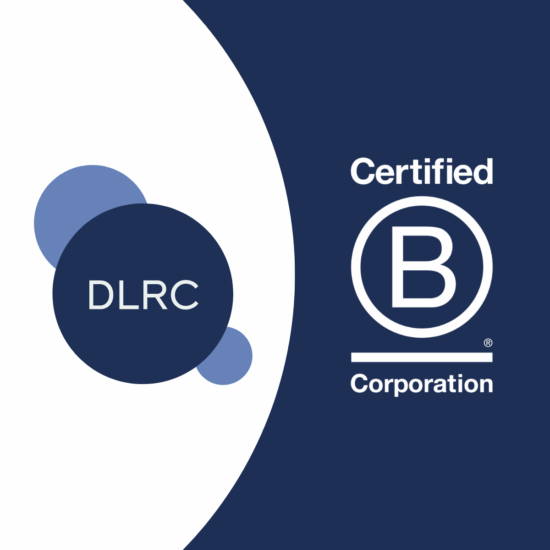Press Release: DLRC Group Becomes a Certified B Corporation
Published Dec 02, 2025
Published 21st July 2025

The US Food and Drug Administration (FDA) and the European Medicines Agency (EMA) are modernising drug development regulations by promoting non-animal testing methods such as organ-on-a-chip and AI models. The development of new medicines is typically founded on a significant package of efficacy and safety studies performed in animals.
The Food and Drug Administration Modernization Act and its associated roadmap aim to make animal testing the exception, improve safety, reduce costs, and align with 3Rs initiatives: Replacement, Reduction and Refinement. These alternative methods are known as New Approach Methodologies (NAMs). The EMA’s 2025 guidelines similarly support NAMs for advanced therapies, emphasising flexibility and global harmonisation. This shift represents both a regulatory and a scientific milestone. One that prioritises innovation, patient safety, and ethical responsibility. Regulatory affairs leaders should proactively prepare to guide their organisations through this transition.
Additionally, the shift toward NAMs supports broader sustainability goals within the pharmaceutical industry. Traditional animal studies are resource-intensive, consuming large volumes of water and energy and generating substantial waste. By reducing reliance on animal testing, NAMs contribute to a more environmentally responsible approach to drug development. This is an increasingly important consideration for companies seeking to meet Environmental, Social, and Governance (ESG) targets.
Regulatory affairs professionals must:
This shift supports sustainability by:
This article provides a concise overview of these regulatory changes from both a regulatory affairs and ESG perspective. Our goal is to:
Recent legislative and regulatory developments in the US and Europe are reshaping nonclinical requirements for drug development. This presents important opportunities and responsibilities for regulatory affairs professionals. Amid growing public and stakeholder demand for ethical and scientifically advanced approaches, both the FDA and EMA are advancing frameworks that enable the adoption of New Approach Methodologies (NAMs) in place of traditional animal testing. Where the pharmaceutical industry has a conflicting impact on the progress towards the United Nations Sustainable Development Goals, developments like this can be seen as a move towards a clearer positive impact.
The development of new medicines has traditionally relied heavily on nonclinical studies in animals to support clinical trials in humans. These studies typically include evaluations of toxicology, pharmacokinetics, pharmacodynamics and safety pharmacology. They are used to identify potential risks, determine safe starting doses, and support the overall benefit-risk assessment.
In a significant regulatory shift, the FDA has announced its intent to phase out the longstanding requirement for animal testing in the preclinical evaluation of drugs, specifically citing monoclonal antibodies and some other biologics. This change marks a new regulatory era, one that recognises the scientific validity and ethical imperative of NAMs.
The Food and Drug Administration Modernisation Act 3.0 is a bipartisan initiative designed to compel the FDA to establish a clear process for approving nonclinical testing methods that do not involve animals. If enacted, the bill would require the FDA to:
This legislation aims to accelerate the transition to human-relevant, innovative testing methods. It ensures the FDA’s regulations align with the intent of the earlier Food and Drug Administration Modernisation Act 2.0, which removed mandatory animal testing requirements in late 2022 but had not been fully implemented by the FDA.
This regulatory evolution is particularly relevant for drugs that belong to well-characterised chemical classes or have known mechanisms of action. In such cases, the FDA is more open to alternative approaches, drawing on precedent and structural or functional similarities with already-approved compounds. Developers can reduce reliance on animal testing by applying the concept of ‘read-across’ science. This allows them to infer safety and efficacy from existing data.
However, the shift does not eliminate the need for rigorous safety evaluation. Regulators may still require animal testing, or equally robust evidence, for novel compounds, drugs with uncertain mechanisms, or those with a narrow therapeutic window. The FDA may permit reduced or no animal testing for biologics like monoclonal antibodies when the drug targets are well understood or when the product is a biosimilar. Nonetheless, first-in-class therapies will continue to face stricter scrutiny to ensure patient safety.
The FDA’s new approach is designed to:
Alongside this, the FDA roadmap serves as a strategic, phased plan to modernise regulatory science by reducing reliance on animal testing and accelerating the adoption of NAMs. It provides a clear, actionable framework for integrating NAMs into regulatory decision-making. The FDA roadmap aims to:
All while upholding scientific integrity and regulatory trust. Through a phased implementation and strong emphasis on collaboration, the roadmap ensures a practical and sustainable transition for both industry and regulators.
New Approach Methodologies (NAMs) refer to innovative, non-animal methods and strategies used to assess the safety and efficacy of chemicals and pharmaceuticals. These include:
These methodologies aim to provide more human-relevant, mechanistic, and high-throughput alternatives to traditional animal-based toxicity tests.
The FDA Roadmap will include:
The FDA Roadmap emphasises making animal studies the exception rather than the rule. This is because there is strong scientific evidence that animal models often fail to accurately predict human responses to drugs. This leads to high failure rates in clinical trials and significant wasted resources.
As science advances, there is growing recognition of the need for more human-relevant, efficient, and ethical approaches. Innovative technologies such as organ-on-chip systems, human cell-based models and computational tools offer promising alternatives that can:
These methods support a more compassionate and sustainable future in drug development.
Historically, the FDA and other regulators required Investigational New Drug (IND) applications to demonstrate safety through animal data before advancing to human clinical trials.
For regulatory affairs professionals, the FDA Roadmap represents a shift toward:
This legal framework allows Sponsors to propose alternative safety and efficacy data, provided it is supported by robust, validated methodologies.
Over the coming year, the FDA intends to initiate a pilot program permitting select monoclonal antibody developers to predominantly utilise non-animal data in lieu of traditional preclinical animal studies. The FDA will provide regulatory guidance and oversight, enabling sponsors to build case law around the acceptability of NAMs in IND submissions. This initiative will likely become a precedent-setting model for broader industry adoption. Findings from this pilot study may subsequently inform broader regulatory changes, such as phased updates to existing guidance.
Although regulators will not completely eliminate animal testing in the short term, this policy shift shows that both the US FDA and the EMA are actively embracing innovation in regulatory science. Within the next three to five years, the FDA aims to make animal studies the exception rather than the norm for preclinical safety and toxicity testing.
As scientists increasingly validate NAMs, regulatory affairs professionals must navigate this evolving landscape with both agility and scientific fluency. Regulators and innovators must balance compliance with innovation. This will ensure that safety, efficacy, and public trust remain paramount as they adopt new data paradigms.
Despite new regulations and the roadmap suggesting alternatives, animal testing remains the current gold standard. Sponsors should not expect their IND applications to be approved based solely on data from NAMs at this stage. If the specific NAM is not yet included in official regulations or guidance, companies should discuss their plans with FDA to ensure regulatory acceptability.
The announcement by the FDA is by far the most significant in terms of a move towards regulatory acceptance of NAMs and phased reduction of the reliance on animal testing. However, the EMA has committed to integrating 3R-compliant methodologies into the regulatory lifecycle. The EMA current and upcoming strategies, covering 2025 and extending to 2028, prioritise regulatory guidance on NAM validation and acceptance, particularly for discovery and toxicology, aiming to reduce animal use and improve the relevance and efficiency of safety assessments. The EMA also focuses on leveraging real-world data, artificial intelligence, and cross-border collaboration to support the development and assessment of safe, effective, and accessible medicines for patients across the EU. In the EU, regulatory agencies can accept data packages based entirely on NAMs if there is sufficient scientific justification. However, real-world examples of submissions without any animal data remain rare.
Globally, organisations such as the International Council for Harmonisation (ICH), International Organisation for Standardisation (ISO), and Organisation for Economic Co-operation and Development (OECD) have begun integrating NAMs into their development protocols. These efforts focus on a tiered or cascade approach that prioritises in vitro and in silico models over animal testing, only resorting to animal studies when unresolved scientific questions remain. The OECD promotes Integrated Approaches to Testing and Assessment (IATA), which combine multiple information sources such as in vitro, computational, and read-across data. This aims to improve hazard and risk assessment while reducing reliance on animals. ICH and OECD are also working to harmonise guidance and validation standards for NAMs. This supports their broader regulatory acceptance and ensuring robust, internationally recognised methods for chemical and pharmaceutical safety. These initiatives collectively reflect a global commitment to more predictive, ethical, and efficient safety science.
In Australia, the Commonwealth Scientific and Industrial Research Organisation (CSIRO) launched a 15-year strategy in 2023 to advance non-animal testing. This strategy outlines national priorities for developing and validating NAMs across health, biosecurity, and biotechnology. Key opportunities include:
The strategy also recommends enhancing coordination, validation, and commercialisation of NAMs, positioning Australia as a global leader in ethical and predictive testing.
The UK government plans to publish a strategy by the end of 2025 to systematically reduce the use of animals in research. Key initiatives include:
This strategy promotes collaboration between government, academia, and industry to accelerate the adoption of advanced alternatives.
These regulatory shifts align with the United Nations Sustainable Development Goals (SDGs), particularly:
They also support wider ESG goals by:
Globally, there is a substantial and accelerating shift toward reducing the use of animals in drug development. This is driven by scientific advancement, ethical considerations, and regulatory leadership. Major regulatory agencies, such as the FDA, EMA and others are implementing strategic roadmaps and guidelines to promote the adoption of NAMs, including in vitro, in silico, and organ-on-a-chip models, as well as the use of real-world and international human safety data.
The FDA Roadmap offers a clear, actionable framework for incorporating NAMs into regulatory decision-making. This shift towards accepting alternatives to animal testing is more than just a procedural update; it’s a sign that the regulatory framework is aligning with scientific advancements. A key shift has occurred: Sponsors now have a regulatory pathway and political backing to initiate early engagement with the FDA, particularly during pre-IND and end-of-Phase 2 meetings, to discuss the potential inclusion of NAMs in lieu of or alongside traditional animal studies.
If regulators do not align there is a risk that the environmental and ethical benefits of this decision could be moot. In this light the UN’s SDG 17 ‘Partnership for the Goals’ is particularly important; advice, information, and pressure from industry may be necessary.
For regulatory professionals, this presents both a challenge and an opportunity: to spearhead strategies around NAMs, engage proactively with regulatory agencies, and ensure that the next generation of therapies reaches patients safely and efficiently.
In addition, the global move toward NAMs in drug development offers significant ESG advantages by reducing environmental harm, advancing sustainability, and strengthening governance across the pharmaceutical sector.
DLRC’s regulatory experts are closely monitoring the development of these regulations and are ready to support sponsors in navigating this evolving landscape. Our team can help you optimise the use of NAMs while ensuring full compliance with all requirements. Contact us today to discuss how we can support you in this evolving regulatory environment by emailing hello@dlrcgroup.com.

Published Dec 02, 2025

Published Nov 14, 2025

Published Oct 20, 2025

Published Oct 01, 2025

Published Oct 01, 2025

Published Oct 01, 2025

Published Oct 01, 2025

Published Oct 01, 2025

Published Sep 29, 2025